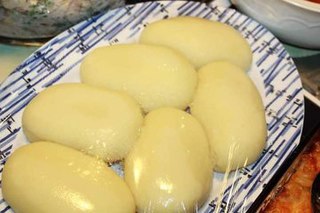
Fufu is a pounded meal found in West African cuisine. It is a Twi word that originates from the Akans in Ghana. The word has been expanded to include several variations of the pounded meal found in other African countries including Sierra Leone, Guinea, Liberia, Cote D'Ivoire, Burkina Faso, Benin, Togo, Nigeria, Cameroon, the Democratic Republic of Congo, the Central African Republic, the Republic of Congo, Angola and Gabon. It also includes variations in the Greater Antilles, where African culinary influence is high.

Indigenous cuisine of the Americas includes all cuisines and food practices of the Indigenous peoples of the Americas. Contemporary Native peoples retain a varied culture of traditional foods, along with the addition of some post-contact foods that have become customary and even iconic of present-day Indigenous American social gatherings. Foods like cornbread, turkey, cranberry, blueberry, hominy, and mush have been adopted into the cuisine of the broader United States population from Native American cultures.
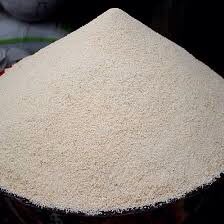
In West Africa, garri is the flour of the fresh starchy cassava root.
Canarian cuisine refers to the typical dishes and ingredients in the cuisine of the Canary Islands, and it constitutes an important element in the culture of its inhabitants. Its main features are the freshness, variety, simplicity, and richness of its ingredients, the mix of seafood and meat dishes, its cultural influences and the low knowledge of it by the rest of the world. Canarian cuisine is influenced by other cultures, especially that of the aboriginal inhabitants of the islands (Guanches), and has influenced Latin American cuisine.

The cuisine of the Democratic Republic of the Congo and the Republic of the Congo varies widely, representing the food of indigenous people. Cassava, fufu, rice, plantain and potatoes are generally the staple foods eaten with other side dishes.

Ghanaian cuisine refers to the meals of the Ghanaian people. The main dishes of Ghana are centered around starchy staple foods, accompanied by either sauce or soup as well as a source of protein. The primary ingredients for the vast majority of soups and stews are tomatoes, hot peppers, and onions. As a result of these main ingredients, most Ghanaian soups and stews appear red or orange.

West African cuisine encompasses a diverse range of foods that are split between its 16 countries. In West Africa, many families grow and raise their own food, and within each there is a division of labor. Indigenous foods consist of a number of plant species and animals, and are important to those whose lifestyle depends on farming and hunting.

Nigerian cuisine consists of dishes or food items from the hundreds of Native African ethnic groups that comprises Nigeria. Like other West African cuisines, it uses spices and herbs with palm oil or groundnut oil to create deeply flavored sauces and soups.

A great variety of cassava-based dishes are consumed in the regions where cassava is cultivated, and the ingredient is included many national or ethnic specialities.

Beninese cuisine involves many fresh meals served with a variety of sauces. Meat is usually quite expensive, and meals are generally light on meat and generous on vegetable fat.

Peanut soup or groundnut soup is a soup made from peanuts, often with various other ingredients. It is a staple African cuisine but is also eaten in East Asia (Taiwan), the United States and other areas around the world. It is also common in some regions, such as Argentina's northwest, Bolivia and Peru, where it can sometimes be served with bone meat and hollow short pasta or fries. In Ghana it is often eaten with fufu, omo tuo and banku often very spicy. Groundnut soup is also a native soup of the Benin (Edo) people in Nigeria and it is often eaten with pounded yam. Some of the essential ingredients used in making it are Piper guineense and Vernonia amygdalina.

Balinese cuisine is a cuisine tradition of Balinese people from the volcanic island of Bali. Using a variety of spices, blended with the fresh vegetables, meat and fish. Part of Indonesian cuisine, it demonstrates indigenous traditions, as well as influences from other Indonesian regional cuisine, Chinese and Indian. The island's inhabitants are predominantly Hindu and culinary traditions are somewhat distinct with the rest of Indonesia, with festivals and religious celebrations including many special foods prepared as the offerings for the deities, as well as other dishes consumed communally during the celebrations.

In Ghanaian cuisine, banku and akple are swallow dishes made of a slightly fermented cooked mixture of maize and cassava doughs formed into single-serving balls.
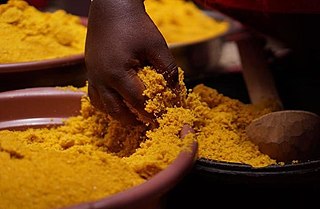
Kpekple is a kind of food eaten by the Gas of Ghana during the celebration of Homowo festival, which is to hoot at hunger. It is prepared with the primary ingredients of steamed and fermented corn meal, palm nut soup and smoked fish. Kpekple is usually sprinkled around by the chief believing that the ancestors would be pleased by the offering.
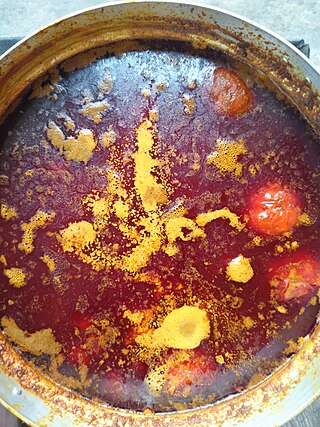
Palm nut soup or banga is a soup made from palm fruit common in the Cameroonian, Ghanaian, Nigerian, Democratic Republic of Congo and Ivorian communities. The soup is made from a palm cream or palm nut base with stewed marinated meats, smoked dried fish, and aromatics. It is often eaten with starch, fufu, omotuo, banku, fonio, or rice. The use of the palm fruit in cooking is significant in Ivorian, Cameronian, Nigerian, Ghanaian, Liberian and other West and Central African cuisine.
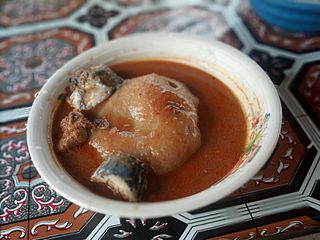
Kokonte, also known as abeti3, lapiiwa, lapelawa or “face the wall”, is a staple swallow food eaten in some parts of Africa including Togo, Ghana and others. In Ghana, kokonte is eaten by most of the ethnic groups like the Ga, Akan, Hausa, Kokonte usually is brown, grey and deep green depending on the type of ethnic group that prepares the dish. Kokonte is usually prepared out of dried cassava or yam.

Otor is a food formulated by the GaDangme tribe of Ghana for special occasions such as: the 'Twins-Festival, Outdooring Naming Ceremony and '8th Day Abrahamic' circumcision, which is now widely observed by other tribes including the Akans, birthday celebration of which predominantly the mashed-yam version of the food is used, with seldom use of the mashed-plantain version, weddings and Dipo/Atofo(or Otofo)/Ashimi puberty rites.
Hausa cuisines are traditional and modern food prepared by Hausa people. It is based on the availability of raw food materials they can farm or provide from other places. Most times Hausa people depend purely on the farm products they have cultivated for food preparations. Hausa people have a meal that is common to most Zongo communities called Tuo Zaafi.

Light Soup is a local indigenous soup of the Akan people of Ghana. Originally formulated as a 'Tomatoes-Base Sea Fish Light Soup' called 'Nkra Nkra(or Aklor)' for fishermen at the coast of Accra, but over the course of time it evolved into a soup prepared with both 'fish and goat-meat', or 'fish and lamb-meat', or 'fish and beef', or 'exclusively the meat of the livestock of choice', and of which the GaDangmes(or Gas) call 'Toolo Wonu', but their neighbouring 'Akans' call 'Aponkye Nkrakra'. The delicious local indigenous 'Light Soup' of the GaDangme(or Ga) people paved the way for the formulation of GaDangme(or Ga) MEALS such as: (1) 'Komi Ke Aklo(or Aklor), Garnished With Cooked Blended Okro', (2) 'Banku Ke Aklo(or Aklor), Garnished With Cooked Blended Okro', (3) 'Yele(Chops of Boiled-Yam) Ke Aklo(or Aklor)', (4) etc., and similar meals of the 'Toolo Wonu' version, and to name a few: (1) 'Yele(Chops of Boiled-Yam) Ke Toolo Wonu', (2) 'Atomo(Chops of Boiled-Potatoes) Ke Toolo Wonu', (3) etc.


















